#that is not leigh hunt in 1822
Text
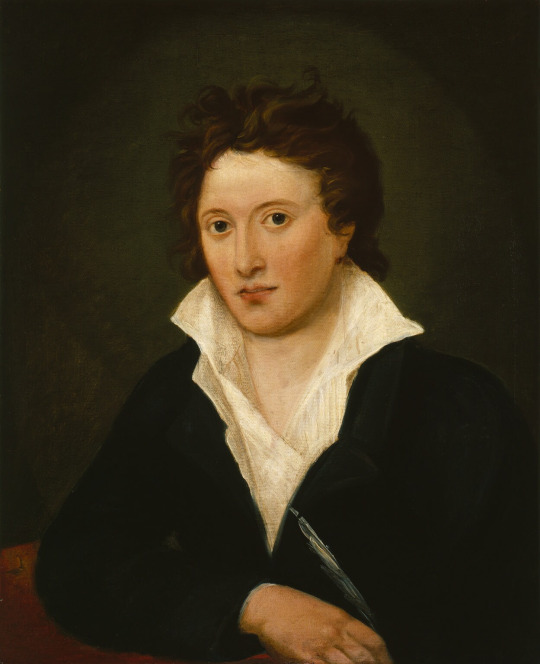
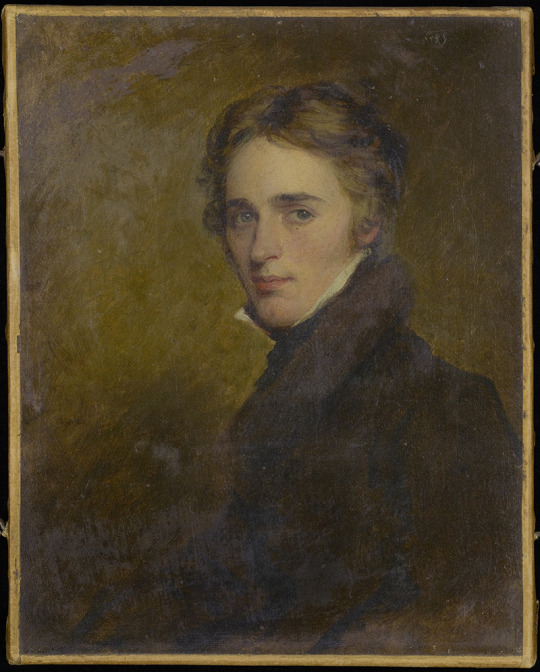
You versus the guy she tells you not to worry about
#i did look this up a few hours after i reblogged that post yesterday(? or was it the other day) I DO BELIEVE IT'S SHELLEY#if only for the fact that it was for most of a century being identified as LEIGH HUNT instead! yeah right#that is not leigh hunt in 1822#i recommend googling the uva library article about it. it shows the full portrait which the telegraph does not in its preview#and that one is also behind a paywall so i couldn't even reeeead it#thank you university of virginia <3#it is not slacking for information btw. there's a forthcoming article by the person who propisitioned that this is shelley#i look forward to it#percy shelley#art#william edward west#romanticism#portraits#sorry amelia curran. your painting is still better than i could do#but i am feral at the thought of having such a professional likeness#THAT IS A REAL MAN BEFORE US#with such believable and realistic features#i want to believe#i know without a proper title given by the painter we'll never really know#but i a million times will accept this is shelley before i accept that the cobbe portrait is shakespeare lol#whenever i see that being published as shakespeare im like. sir. that's clearly thomas overbury#chandos portrait stans rise#sorry i dont often post about it but i am obsessed with likenesses of famous ppl especially disputed ones#especially disputed ones before the innovation or proliferation of photography!!! cuz wow!!!!
134 notes
·
View notes
Text
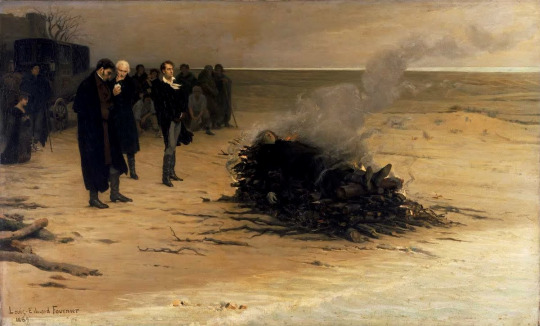
The Funeral of Shelley, Louis Édouard Fournier 1889. "Percy Bysshe Shelley, the Romantic poet, drowned in 1822. His yacht was wrecked in a storm in the Gulf of Spezzia, Italy. His body was cremated and his remains later buried at the Protestant cemetery in Rome. Fournier's painting shows the funeral pyre surrounded by three of the dead poet's closest friends. From left to right they are the author and adventurer Trelawny and Shelley’s fellow-poets Leigh Hunt and Byron. In Trelawny's own account of the event, 'Recollections of the Last Days of Shelley and Byron', he described the hot August day on which the funeral took place. Fournier chose to ignore this aspect of the description. Instead he depicted the weather as grey and cold to accentuate the sombre and dramatic mood of the piece." (National Museums Liverpool).
#dark aesthetic#dark art#dark#darkness#goth aesthetic#goth#romanticism#darkest academia#dark academia#romantic goth#romantic aesthetic#romantic art#gloomy
25 notes
·
View notes
Text
“Lines to ⸻.” also known as “Sonnet to Byron” written by Percy Shelley (1821, fair-copied in 1822) and published posthumously. Shelley had threatened to give up writing due to his lack of success. Byron’s fame and Shelley’s great admiration for his recent works often frustrated Shelley and worsened his depression, despite Byron generally encouraging him. In an early draft below, Shelley began with the line “I am afraid these verses will not please you, but” before seemingly drawing over it with trees.


“If I esteemed you less, Envy would kill
Pleasure, and leave to Wonder and Despair
The ministration of the thoughts that fill
My mind, which, like a worm whose life may share
A portion of the unapproachable,
Marks your creations rise as fast and fair
As perfect worlds at the creator’s will,
And bows itself before the godhead there.
But such is my regard, that, nor your fame
Cast on the present by the coming hour
Nor your well-worn prosperity and power
Move one regret for his unhonoured name
Who dares these words. — the worm beneath the sod
May lift itself in worship to the God.”
The fair-copy was made about six months before Shelley, Edward Williams, and their boatman Charles Vivien all died in a sailing wreck during a storm while returning from visiting Lord Byron and Leigh Hunt. Thomas Medwin said that Byron never saw the poem, and it’s likely, given that it was never shared or published until long after Byron died (about two years after Shelley).
Sources: Percy’s handwritten draft from the Digital Bodleian Library, MS. Shelley adds. e. 17 p. 94 https://digital.bodleian.ox.ac.uk/objects/0f0cba27-6264-4c4e-8b03-3a83c700c1f5/surfaces/1d16ddc7-3cf9-4c96-b435-36f2077168d1/ - Percy’s handwritten fair copy from the British Library Digitized Manuscripts Collection, Zweig MS 188 https://www.bl.uk/manuscripts/FullDisplay.aspx?ref=Zweig_MS_188&index=16 - Transcriptions from The Manuscripts of the Young Romantics: Percy Shelley, vol. 8 (Garland, 1997) https://archive.org/details/faircopymanuscri0008shel/page/249/mode/1up?q=Sonnet+
#im just fascinated by the odd dynamics of their social group#my favorite depressed & insecure writers#he literally called byron a god and himself a worm#oddly enough this is not the first time shelley calls himself a worm compared to byron - see: ‘the sun has extinguished the glow worm’#poetry#english literature#literature#percy shelley#lord byron#the romantics#romanticism#dark academia#writing#history#1800s#poems#romantics#bookblr#reading#english#lit#geneva squad#the geneva squad#books#poets#regency#19th century#english studyblr#english poetry#romantic poets
101 notes
·
View notes
Photo

Louis Édouard Fournier, The Funeral of Shelley, 1889
from narrativepainting.net :
Percy Bysshe Shelley was a tour-de-force Romantic poet. By the time of his death, just before his 30th birthday, he was already famous for numerous poems and his philosophical masterpiece Prometheus Unbound from 1820. He held radical views about economics, morality, and using non-violent means of revolution that influenced thinkers from Karl Marx to Mahatma Gandhi. Shelley had a group of progressive thinkers around him, including his second wife Mary Shelley, best known for her masterpiece Frankenstein.
On July 8, 1822 Shelley drown (with two other men) in his sailing boat in the Gulf of La Spezia when a sudden storm came on. Some think that he was depressed and wanted to die, while others have come up with all kinds of conspiracy theories about murder, but in all likelihood, poor ship design and poor navigation skills is probably what killed him. Fournier depicts the funeral on the beach at Viareggio with Shelley’s friends and fellow writers Edward John Trelawny, Leigh Hunt, and Lord Byron. Mary Shelley is seen behind them kneeling, although this is an invention of Fournier; women were not allowed to attend funerals in pre-Victorian times for health reasons.
23 notes
·
View notes
Text
La pregunta
Soñé que al caminar, extraviado,
se trocaba el invierno en primavera,
y el alma me llevó su olor mezclado
con el claro sonar de la ribera.
En su borde de césped sombreado
vi una zarza que osaba, prisionera,
la otra orilla alcanzar con una rama,
como suele en sus sueños el que ama.
Allí la leve anémona y violeta
brotaban, y estelares margaritas
constelando la hierba nunca quieta;
campánulas azules; velloritas
que apenas rompen su mansión secreta
al crecer; y narciso de infinitas
gotas desfallecido, que del viento
la música acompasa y movimiento.
Y en la tibia ribera la eglantina,
la madreselva verde y la lunada;
los cerezos en flor; la copa fina
del lirio, hasta los bordes derramada;
las rosas; y la hiedra que camina
entre sus propias ramas enlazada;
y azules o sombrías, áureas, rosas,
flores que nadie corta tan hermosas.
Mas cerca de la orilla que temblaba
la espadaña su nieve enrojecía,
y entre líquida juncia se doblaba.
El lánguido nenúfar parecía
como un rayo de luna que se pasaba
entre los robles verdes, y moría
junto a esas cañas de verdor tan fino,
que el alma pulsan con rumor divino.
Pensé que de estas flores visionarias
cortaba un verde ramo, entretejido
con sus juntas bellezas y contrarias,
para guardar las horas que he vivido,
las horas y las flores solitarias,
en mi mano infantil, igual que un nido.
Me apresuré a volver. Mis labios: «¡Ten
estas flores!», dijeron. Pero ¿a quién?
Percy Shelley (1822) en Leigh Hunt's Literary Pocket-Book
#romanticism#romanticismo#percy shelley#mary shelley#english literature#english poetry#literatura inglesa#poesía inglesa#la pregunta#the question
0 notes
Photo


Louis Edouard Fournier (1857-1917), The Funeral of Shelley, 1889, oil on canvas, 129.5 x 213.4 cm. Walker Art Gallery
-
Percy Bysshe Shelley, the Romantic poet, drowned in 1822 when his yacht was wrecked in a storm in the Gulf of Spezzia, Italy. His body was cremated and his remains later buried at the Protestant cemetery in Rome. Fournier’s painting shows the funeral pyre surrounded by three of the dead poet’s closest friends. From left to right, they are the author and adventurer, Trelawney, Leigh Hunt and Shelley’s fellow-poet, Lord Byron.
In Trelawney’s own account of the event, 'Recollections of the Last Days of Shelley and Byron', he described the hot August day on which the funeral took place. Fournier chose to ignore this aspect of the description, depicting the weather conditions as grey and cold in order to accentuate the sombre and dramatic mood of the piece.
#louis edouard fournier#british art#19th century art#art details#painting#art history#old paintings#classic art#figurative painting#percy shelley#funeral
328 notes
·
View notes
Text
I’m Looking For Descendants Of William Willans Willans(1822-1903)

William Willans Willans is standing on back row 5th from left.
I'm looking for descendants of William Willans Willans(1822-1903) to share some information.
Son of William Hall Willans &Mary Church. He married Lucy Blundell.His issue:-
i)William Blundell Willans(1852-1915) married Henrietta Amelia Jeune.
His issue:-
ci)Gordon Jeune Willans(1883-1963)married to Ruth Inskip.
His issue:-
di)Robert Inskip Willans(1917-2001)married to Elizabeth Ellen Tuffield.
His issue:-
ei)Carolyn Mary Jeune Willans married to Stephen G.Townsend.
eii) Simon William Tuffield Willans married Jennifer J Rezgalla
dii)William Digby Willans(1922-?) married to Enid Kathleen Mercer.
His issue:-
ei) Timothy Jeune Willans married Fiona J Hutton.
His issue:-
fi) Adam Jeremy Willans
fii) Laura Alice Willans
fiii) Charles David Willans
cii)Elsie Jeune Willans(1882-?)
ciii)Eva Jeune Willans(1883-1937) married Townsend Wharton Shaw.
civ)Sir Frederick Jeune Willans(1883-1949) married to Wynefred C M Manby.
cv)Maxwell Jeune Willans(1886-1906).
cvi)Lucy Jeune Willans(1889-1980) married Aubrey Barker
Their issue:-
di) Derek Barker
dii) David A Barker
diii) Ronald Barker
div) Phyllis V Barker
cvii)Norman Jeune Willans(1892-1948) married Anne Marie ?.
cviii)Alan Jeune Willans(1896-1918).
cx) Violet Jeune Willans(1902-1954)
cxi) Marguerite Jeune Willans(1902-1968)
ii)Gertrude Harriet Mann Willans(1855-1928).
iii)Thomas Church Willans(1857-1890) married to Elizabeth Ann Avery.
His issue :-
ci)Bessie Gwendoline Willans married to Roderic Arthur Clapham.
Their issue:-
di) Deborah K R Clapham married Geoffrey N Hunt.
Their issue:-
ei) David R N Hunt
iv) Charles Wellesley Willans(1859-1884).
v)Harry Walter Willans(1862-1953) married to Catherine Vaughan de Jersey Clere.
His issue:-
ci)Willam Murray Willans married to Blanche Rose Walker.
His issue:-
di)Malcolm Murray Willans(1921-1978) married Eileen Spurdle.
His issue:-
ei)Ashley Willans married Lizanne Hogg.
eii)Ian Willans married Jenny Blinkhorn.
eiii)Suzanne Willans married Peter Linklater.
dii)Harry Leonard Willans married to Dorothy Mary Johnstone.His issue:-
ei)Neil Robert Willans married to Sandra Dymond.His issue:-
fi)Mark James Willans.
fii)Julie Sara Willans.
eii)Sally Diane Willans married Roger Menzies.Their issue:-
fi)Erin Leigh Menzies.
fii)Kelly Andrea Menzies.
fiii)Scott Andrew Menzies.
eiii)Delys Marie Willans.
cii)Lucy Willans married Ernest Picot.Their issue:-
di) David Picot.
dii)Peter Picot.
diii)Nancy Picot married Bob Hope-Gibbons.
div)Elizabeth Picot.
ciii)Dorothy Willans married Percy Hodson.Their issue:-
di)Catherine Hodson.
dii)Sydney Hodson.
diii)Mary Hodson. div) Fraser Hodson.
dv) Pam married Jim Sharpe.
vi) Lucy Augusta Willans(1865-1876).
Please contact me at:- [email protected]
1 note
·
View note
Photo
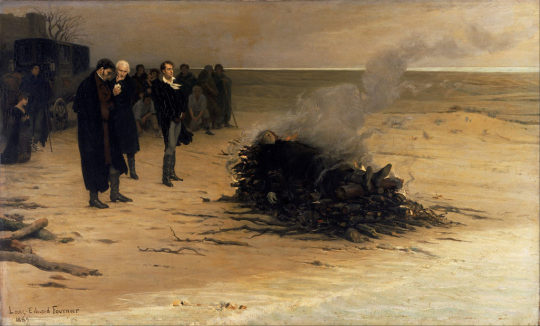
Louis Édouard Fournier, The Funeral of Shelley, 1889
from narrativepainting.net :
Percy Bysshe Shelley was a tour-de-force Romantic poet. By the time of his death, just before his 30th birthday, he was already famous for numerous poems and his philosophical masterpiece Prometheus Unbound from 1820. He held radical views about economics, morality, and using non-violent means of revolution that influenced thinkers from Karl Marx to Mahatma Gandhi. Shelley had a group of progressive thinkers around him, including his second wife Mary Shelley, best known for her masterpiece Frankenstein.
On July 8, 1822 Shelley drown (with two other men) in his sailing boat in the Gulf of La Spezia when a sudden storm came on. Some think that he was depressed and wanted to die, while others have come up with all kinds of conspiracy theories about murder, but in all likelihood, poor ship design and poor navigation skills is probably what killed him. Fournier depicts the funeral on the beach at Viareggio with Shelley’s friends and fellow writers Edward John Trelawny, Leigh Hunt, and Lord Byron. Mary Shelley is seen behind them kneeling, although this is an invention of Fournier; women were not allowed to attend funerals in pre-Victorian times for health reasons.
34 notes
·
View notes
Photo


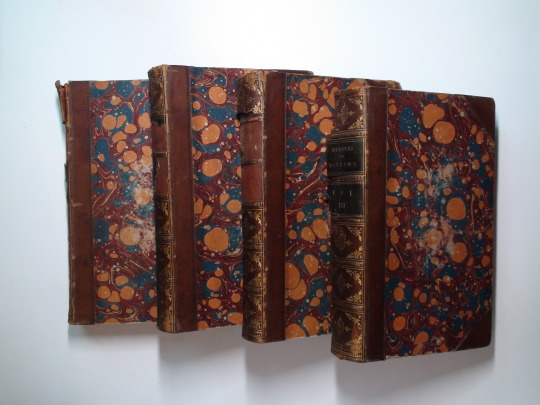
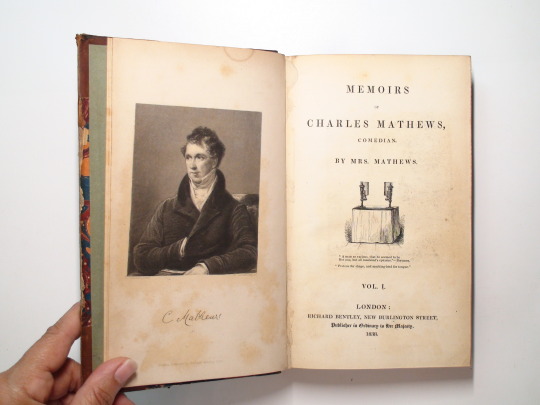

Memoirs Of Charles Mathews
Comedian
By Mrs. Mathews
VOL I-III
LEATHER
COMPLETE IN FOUR VOLUMES
SCARCE
ABOUT CHARLES MATTHEWS
Charles Mathews (28 June 1776, London – 28 June 1835, Devonport) was an English theatre manager and comic actor, well known during his time for his gift of impersonation and skill at table entertainment. His play, At Home, in which he played every character, was the first monopolylogue and the defining work in the genre.
For several years Mathews took bit parts, but on 15 May 1803, he made his first London appearance at the Haymarket, as Jabel in Cumberland's The Jew and as Lingo in The Agreeable Surprise. As a continued public success, he was taken on at the Drury Lane. His gift for mimicry enabled him to disguise his personality without a change of costume. His versatility and originality were displayed in his one-man show, or "monodramatic entertainment," entitled At Home or Matthews at Home, which he initiated in the Lyceum Theatre in 1808. Leigh Hunt wrote that his table entertainments "for the richness and variety of his humor, were as good as half a dozen plays distilled." The show combined mimicry, storytelling, recitations, improvisation, quick-change artistry, and comic song.
In 1822-1823 Mathews toured the United States (US) to great success. During his stay, he developed a number of impressions of American types. One of these was the African American, said to have been based on the American black actor James Hewlett, who performed Shakespeare roles at the African Grove. In his next show, A Trip to America, Mathews sang a version of the popular slave freedom song, "Possum Up a Gum Tree", performing in dialect and possibly in blackface. One author called him "the paterfamilias of the Yankee theatre and the progenitor of all native American dialect comedy."
Publisher: Printed by Richard Bentley, New Burlington Street, Publisher in Ordinary to Her Majesty, London
Copyright: 1838-1839
BUY ON ETSY
BUY ON eBAY
#Charles Mathews#comedian#actors#famous actors#british actors#humor#biography#leather book#bookish#booklr#books#old books#monodramatic entertainment#books and reading#british theater#first editions#antiquarian books
7 notes
·
View notes
Photo
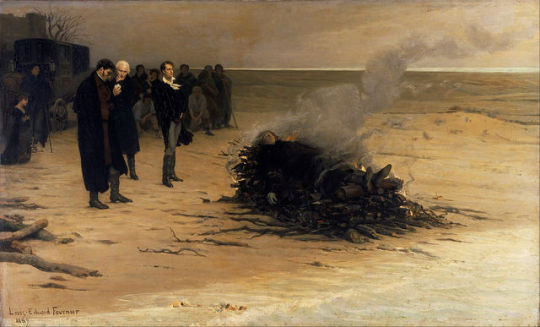
The Funeral of Shelley, 1889, by Louis Édouard Fournier
Percy Bysshe Shelley, the famous Romantic poet, drowned in 1822 when his yacht was wrecked by a storm in the Gulf of Spezzia, Italy. His body was cremated and his remains later buried at the Protestant cemetery in Rome. Fournier’s painting shows the funeral pyre surrounded by three of the dead poet’s closest friends, from left the author and adventurer, Trelawney, Leigh Hunt and Shelley’s fellow poet, Lord Byron. Trelawney described the event in ‘Recollections of the Last Days of Shelley and Byron’.
It was the hot August day but Fournier chose to ignore this aspect of the description, depicting the weather conditions as grey and cold in order to accentuate the sombre and dramatic mood of the painting. –Google Arts & Culture
2 notes
·
View notes
Video
PA Ricketts Glen State Park 01 by zwzzjim
Via Flickr:
Ricketts Glen State Park is a Pennsylvania state park on 13,050 acres (5,280 ha) in Columbia, Luzerne, and Sullivan counties in Pennsylvania in the United States. Ricketts Glen is a National Natural Landmark known for its old-growth forest and 24 named waterfalls along Kitchen Creek, which flows down the Allegheny Front escarpment from the Allegheny Plateau to the Ridge-and-Valley Appalachians. The park is near the borough of Benton on Pennsylvania Route 118 and Pennsylvania Route 487, and is in five townships: Sugarloaf in Columbia County, Fairmount and Ross in Luzerne County, and Colley and Davidson in Sullivan County. Ricketts Glen's land was once home to Native Americans. From 1822 to 1827, a turnpike was built along the course of PA 487 in what is now the park, where two squatters harvested cherry trees to make bed frames from about 1830 to 1860. The park's waterfalls were one of the main attractions for a hotel from 1873 to 1903; the park is named for the hotel's proprietor, R. Bruce Ricketts, who built the trail along the waterfalls. By the 1890s Ricketts owned or controlled over 80,000 acres (320 km2; 120 sq mi) and made his fortune clearcutting almost all of that land, including much of what is now the park; however he preserved about 2,000 acres (810 ha) of virgin forest in the creek's three glens. The sawmill was at the village of Ricketts, which was mostly north of the park. After his death in 1918, Ricketts' heirs began selling land to the state for Pennsylvania State Game Lands. Plans to make Ricketts Glen a national park in the 1930s were ended by budget issues and the Second World War; Pennsylvania began purchasing the land in 1942 and fully opened Ricketts Glen State Park in 1944. The Benton Air Force Station, a Cold War radar installation in the park, operated from 1951 to 1975 and still serves as airport radar for nearby Wilkes-Barre and as the Red Rock Job Corps Center. Improvements since the creation of the state park include a new dam for the 245-acre (99 ha) Lake Jean, the breaching of two other dams Ricketts built, trail modifications, and a fire tower. In 1999 Hurricane Floyd briefly closed the park and downed thousands of trees; helicopter logging protected the ecosystem while harvesting lumber worth nearly $7 million, some of which paid for a new park office in 2001. The park offers hiking, ten cabins, camping (one of the two camping areas is on a peninsula in the lake), horseback riding, and hunting. Lake Jean is used for swimming, fishing, canoeing and kayaking. In winter there is cross-country skiing, ice fishing on the lake, and ice climbing on the frozen falls. The Glens Natural Area has eight named waterfalls in Glen Leigh and ten in Ganoga Glen, these come together at Waters Meet; downstream in Ricketts Glen there are four to six named waterfalls. The park has four rock formations from the Devonian and Carboniferous periods, and is home to a wide variety of plants and animals. It was named an Important Bird Area by the Pennsylvania Audubon Society and is an Important Mammal Area too. Ricketts Glen State Park was chosen by the Pennsylvania Department of Conservation and Natural Resources (DCNR) and its Bureau of State Parks as one of "25 Must-See Pennsylvania State Parks". from Wikipedia
#outdoor#landscape#serene#blue#bridge#sky#adventure#plant#tree#waterfront#water#dawn#Summar#Lake#waterscape#Ricketts#Glen#State#Park#fall#waterfall
1 note
·
View note
Photo

Romantics, Poets and “Unfortunate Lunatics” All art shown is original, historically inspired, and for sale on the website. The books are reproductions of the frontispiece of gothic works, alongside original artwork made from actual salvaged antique books. Tarot cards are from the historically inspired Ofgraveconcern Industrial Sublime tarot 1760 - 1848. See link in bio. 19th October 1784, birth of English critic, essayist, poet and co-founder of ‘The Examiner’ Leigh Hunt; founder of the ‘Hunt circle’, which included William Hazlitt, Charles Lamb, John Keats, Percy Bysshe Shelley and Lord Byron. Hunt was also present at Shelley’s funeral in 1822, as his body was burned on the beach of the bay of Viareggio in Italy, after his drowning. Legend says that Shelley’s friend, adventurer Edward Trelawny pulled out Shelley’s heart before it caught fire, giving it to Mary Shelley. Hunt also was associated with William Blake, although not in the same friendly terms he shared with his circle. In 1809, the Examiner published a scathing attack on William Blake’s one and only public showing of his work, written by Hunt’s brother Robert claiming that Blake was"an unfortunate lunatic" suffering from "egregious vanity". The review resulted in Blake never again publicly showing his work, and calling Hunt and the Examiner “a nest of villains”. In response Hunt added Blake to his list of “quacks”. 21st October 1772, birth of English poet, literary critic and philosopher Samuel Taylor Coleridge. Alongside his fellow poet and friend William Wordsworth, Coleridge began the romantic movement in England, founding the Lake Poets. Enchanted initially by the French revolution, William Wordsworth visited France in 1791 to share what many believed would be the start of a new world. Like many however the Reign of Terror in the following three years would leave this utopian ideal in ruins. #romanticpoets #gothicliterarure #leighhunt #percyshelley #williamblake #johnkeats #samueltaylorcoleridge #williamwordsworth #literarymemes #gothicart #history #18thcentury #19thcentury #reproduction #tarot #tarotdecks #tarotart #tarotartist #tarotartwork #history #historical #interestingfacts #art https://www.instagram.com/p/CGxdkyug2a4/?igshid=5d1a35sfpu70
#romanticpoets#gothicliterarure#leighhunt#percyshelley#williamblake#johnkeats#samueltaylorcoleridge#williamwordsworth#literarymemes#gothicart#history#18thcentury#19thcentury#reproduction#tarot#tarotdecks#tarotart#tarotartist#tarotartwork#historical#interestingfacts#art
0 notes
Photo
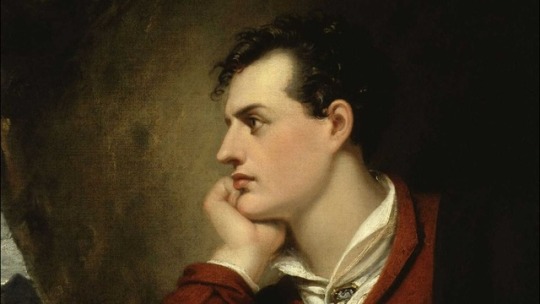
Arrivals & Departures - 04 August 1792
Celebrate Percy Bysshe Shelley Day
Percy Bysshe Shelley (/bɪʃ/ (listen) BISH; 4 August 1792 – 8 July 1822) was one of the major English Romantic poets, who is regarded by some as among the finest lyric and philosophical poets in the English language, and one of the most influential. A radical in his poetry as well as in his political and social views, Shelley did not see fame during his lifetime, but recognition of his achievements in poetry grew steadily following his death. Shelley was a key member of a close circle of visionary poets and writers that included Lord Byron, John Keats, Leigh Hunt, Thomas Love Peacock and his own second wife, Mary Shelley, the author of Frankenstein.
Shelley is perhaps best known for classic poems such as "Ozymandias", "Ode to the West Wind", "To a Skylark", "Music, When Soft Voices Die", "The Cloud" and The Masque of Anarchy. His other major works include a groundbreaking verse drama, The Cenci (1819), and long, visionary, philosophical poems such as Queen Mab (later reworked as The Daemon of the World), Alastor, The Revolt of Islam, Adonais, Prometheus Unbound(1820) – widely considered to be his masterpiece –, Hellas: A Lyrical Drama (1821) and his final, unfinished work, The Triumph of Life (1822).
Shelley's close circle of friends included some of the most important progressive thinkers of the day, including his father-in-law, the philosopher William Godwin, and Leigh Hunt. Though Shelley's poetry and prose output remained steady throughout his life, most publishers and journals declined to publish his work for fear of being arrested for either blasphemy or sedition. Shelley's poetry sometimes had only an underground readership during his day, but his poetic achievements are widely recognized today, and his political and social thought had an impact on the Chartist and other movements in England, and reach down to the present day. Shelley's theories of economics and morality, for example, had a profound influence on Karl Marx; his early – perhaps first – writings on nonviolent resistance influenced Leo Tolstoy, whose writings on the subject in turn influenced Mahatma Gandhi, and through him Martin Luther King Jr. and others practicing nonviolence during the American civil rights movement.
Shelley became a lodestar to the subsequent three or four generations of poets, including important Victorian and Pre-Raphaelite poets such as Robert Browning and Dante Gabriel Rossetti. He was admired by Oscar Wilde, Thomas Hardy, George Bernard Shaw, Leo Tolstoy, Bertrand Russell, W. B. Yeats, Upton Sinclair and Isadora Duncan. Henry David Thoreau's Civil Disobedience was apparently influenced by Shelley's writings and theories on non-violence in protest and political action. Shelley's popularity and influence has continued to grow in contemporary poetry circles.
0 notes
Text
LORD BYRON. (George Gordon; Londres, Gran Bretaña, 1788 - Missolonghi, actual Grecia, 1824) Poeta británico. Perteneciente a una familia de la aristocracia de su país, perdió a su padre a los tres años. En 1798, al morir su tío abuelo William, quinto barón Byron, heredó el título y las propiedades.
Lord Byron
Educado en el Trinity College de Cambridge (etapa en la que curiosamente se distinguió como deportista, a pesar de tener un pie deforme de nacimiento), Lord Byron vivió una juventud amargada por su cojera y por la tutela de una madre de temperamento irritable. A los dieciocho años publicó su primer libro de poemas, Horas de ocio, y una crítica adversa aparecida en el Edimburgh Review provocó su violenta sátira titulada Bardos ingleses y críticos escoceses, con la que alcanzo cierta notoriedad.
En 1809, al ser declarado mayor de edad, Lord Byron emprendió una serie de viajes en los que recorrió España, Portugal, Grecia y Turquía. A su regreso publicó, como memoria poética de su viaje, los dos primeros cánticos de La peregrinación de Childe Harold, que le valieron rápidamente la fama. El héroe del poema, Childe Harold, parece basado en elementos autobiográficos, aunque sin duda recreados y aumentados para configurar lo que sería el típico héroe byroniano -al que él mismo trató de emular en su vida-, caracterizado por la rebeldía frente a la moral y las convenciones establecidas y marcado por una vaga nostalgia y exaltación de sentimientos, en especial el sufrimiento por un indeterminado pecado original.
En 1815 se casó con Anna Isabella Mibanke, con quien tuvo una hija, Augusta Dada, aunque se separaron al cabo de un año. El personaje libertino y amoral que Lord Byron encarnaba frente a la sociedad terminó por volverse contra él, sobre todo a partir de los rumores sobre sus relaciones incestuosas con su hermanastra Augusta, por lo que terminó por abandonar el Reino Unido en 1816, para no regresar jamás y convertirse en poeta errante por Europa.
En Suiza, de donde había llegado procedente de Bélgica, Lord Byron convivió con el poeta Shelley y sostuvo relaciones amorosas con Claire Clairmont. Tras una estancia en Génova, se trasladó a Venecia, donde inició, en 1819, una nueva y turbulenta relación amorosa con la condesa Guiccioli y llevó una vida fastuosa y salpicada de escándalos; más tarde fue a Ravena.
En esta época terminó el cuarto canto de Childe Harold y su Manfredo (1817), que le permitió sostener correspondencia con Goethe, quien diría de él que se trataba del «primer talento de su siglo». En 1819 inició su famoso Don Juan, considerada por muchos como su mejor obra, en la que recrea al mítico personaje en un tono que oscila entre la gravedad y la ironía. En 1822, y junto a los poetas Shelley y Leigh Hunt, fundó en Pisa la revista The Liberal, cuya publicación se interrumpió enseguida debido a la muerte del primero y a la disputa de Byron con Hunt.
Orientado cada vez más hacia la causa liberal, en 1823, a raíz de la rebelión de los griegos contra los turcos, Lord Byron reclutó un regimiento para la causa de la independencia griega, aportó sumas económicas importantes y se reunió con los insurgentes en julio de 1823 en Missolonghi. Murió de unas fiebres en esta misma ciudad poco después, a los treinta y seis años de edad.
La fama de que gozó en su época se ha visto reducida en gran medida con el paso de los años y el aumento de la perspectiva histórica. Se ha discutido el valor literario y sobre todo el carácter innovador de sus composiciones líricas, mientras que su facilidad versificadora y su expresión ágil e incisiva mantienen el interés de sus sátiras y composiciones narrativas. Byron encarnó para sus coetáneos el ideal del héroe romántico, tanto en su obra como en su vida, y como tal fue considerado y admirado por no pocos escritores, José de Espronceda y Gustavo Adolfo Bécquer entre ellos. — con Jesús A'Ramos.
0 notes
Text
Mary Shelley's Favorite Keepsake: Her Dead Husband's Heart
Percy Bysshe Shelley was just 29 when he drowned after his boat, Don Juan, was caught in a storm on July 8, 1822. Shelley's body and those of his two sailing companions were found 10 days later, identifiable only by their clothing. Shelley had stashed a book of John Keats poems in his pocket.
The poet was cremated, but for some reason, his heart refused to burn. Modern-day physicians believe it may have calcified due to an earlier bout with tuberculosis. Though Percy’s friend, Leigh Hunt, originally claimed the heart—he was there for the funeral pyre-style cremation and felt he had a right to keep the unscathed organ—it was eventually turned over to Mary.
Instead of burying it with the rest of his remains in the Protestant Cemetery in Rome, Mary kept the heart in a silken shroud, and is said to have carried it with her nearly everywhere for years. In 1852, a year after she died, Percy’s heart was found in her desk. It was wrapped in the pages of one of his last poems, Adonais. The heart was eventually buried in the family vault with their son, Percy Florence Shelley, when he died in 1889.
#mary shelley#mary shelley's heart#mary shelley husband's heart#mary shelley heart#percy bysshe shelley
0 notes